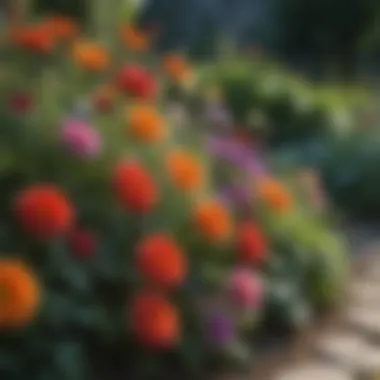Best Cut Flowers for Zone 5: Comprehensive Guide


Intro
Selecting cut flowers that thrive in USDA Hardiness Zone 5 presents unique challenges and opportunities for gardening enthusiasts. This zone experiences a range of temperatures, characterized by cold winters and moderate summers. Understanding the specific climatic conditions helps in choosing flowers that not only survive but also flourish.
Careful consideration of the flowers' attributes, such as blooming seasons, color, and resilience, maximizes both aesthetic appeal and longevity. This guide embarks on a thorough exploration of the best cut flowers for Zone 5, enabling both novice gardeners and seasoned enthusiasts to create stunning floral arrangements for their homes or events.
Whether you are aiming to enhance your garden's visual appeal or looking to elevate an indoor space, knowledge about the best varieties can significantly impact the success of your floral endeavors. Let's begin by delving into the core aspects that will shape our understanding throughout this guide.
Understanding Hardiness Zone
Understanding Hardiness Zone 5 is essential for gardening success. This zone, identified by the USDA, comprises areas where the average minimum winter temperature ranges from -20°F to -10°F (-29°C to -23°C). Grasping this concept enables gardeners to make informed decisions when choosing plants, especially cut flowers. It ensures that the selected varieties can endure the local climate, leading to healthier and more resilient plants.
When selecting flowers for cut arrangements, awareness of these winter temperature limits informs the care they require during the growing season. For example, it is crucial to know which species are more tolerant of colder weather. This consideration not only enhances the garden's aesthetics but also affects maintenance practices. Knowing the hardiness can save time and resources by reducing plant loss due to unsuitable weather conditions.
Climate Characteristics
The climate within Zone 5 presents distinct characteristics that influence gardening practices. This zone typically experiences four distinct seasons; cold winters, warm summers, and transitional falls and springs. The growing season generally spans from early May to late September, providing ample time for various flowering species to bloom.
The relatively moderate climate allows for a diverse range of cut flowers. During the summer, temperatures often reach into the 70s°F (20s°C), creating favorable conditions for growth. However, gardeners must remain vigilant of nights that can be brisk, especially in early spring and fall, which can affect young plants or newly sown seeds. Precipitation varies, so understanding local rainfall patterns will aid in creating effective watering practices.
Frost Dates
Frost dates are critical for gardeners in Zone 5. Knowing the last spring frost and first fall frost dates informs planting and harvesting decisions. For those in this zone, the average last frost occurs between late April and early May, while the first frost typically arrives between late September and mid-October.
These dates can vary slightly depending on specific local conditions. Therefore, it is advisable to consult local agricultural extensions or weather services for precise information. Proper timing helps ensure that tender plants are sown after the risk of frost has passed and harvested before the first frost threatens their viability.
"Understanding frost dates can significantly reduce the risk of crop failure while enhancing the biodiversity in your garden."
Importance of Choosing the Right Cut Flowers
Selecting cut flowers appropriate for Hardiness Zone 5 has significant implications for both aesthetic and practical gardening goals. Understanding the interplay between environment and plant selection enables gardeners to achieve not only beauty but also lasting satisfaction from their floral arrangements. This section elucidates why choosing the right cut flowers plays a pivotal role in any successful gardening endeavor.
Aesthetic Appeal
One cannot overlook the impact of cut flowers on visual aesthetics. Selecting the right variety can transform a typical space into a stunning vignette. The colors, shapes, and fragrance of carefully chosen flowers contribute to the overall ambiance of a garden or home. Roses, for example, are often celebrated for their romantic allure and rich colors, while sunflowers radiate joy with their bright yellow petals.
Beyond personal preference, considerations like seasonal blooms and color palettes are vital. In Zone 5, where the climate affects growing conditions, selecting flowers that bloom at varied times ensures continuous beauty throughout the seasons. For instance, pairing early-blooming daffodils with late-blooming chrysanthemums creates a visually dynamic and pleasing garden.
Utilizing cut flowers in decor also enhances spaces. Whether adorning a dining table or serving as a centerpiece at an event, well-chosen flowers elevate the aesthetics. The interaction of natural colors with interior design elements fosters a cohesive atmosphere.
Longevity and Preservation
Equally important is the longevity of cut flowers. A gardener must not only choose flowers that look good but also those that can last once cut. Factors such as stem thickness, water retention ability, and flowering habits greatly influence how long cut flowers will stay fresh in a vase.
For instance, peonies, while exquisite, have a shorter vase life compared to sturdier flowers like zinnias. Understanding these differences helps in making informed decisions. Furthermore, certain flowers do not respond well to post-harvest handling. Learning specific methods for each type, such as rehydration techniques or optimal cutting times, can prolong floral arrangements significantly.
Here are a few tips to enhance longevity of cut flowers:
- Fresh Cut at an Angle: Cutting stems at an angle increases water absorption.
- Remove Lower Leaves: This prevents decay in the water, which can limit the lifespan of flowers.
- Cool Storage: Keeping flowers in a cool environment before arranging can also help maintain freshness.
In summary, the careful selection of cut flowers tailored to Hardiness Zone 5 not only enhances visual appeal but also ensures longer enjoyment in personal spaces. Understanding these aspects demonstrates a commitment to quality gardening and interior decor.
Top Cut Flowers for Zone Conditions
Choosing the right cut flowers for USDA Hardiness Zone 5 is vital for both aesthetics and practicality. This zone experiences a range of climate conditions that influence what can thrive. From cold winters to warm summers, selecting cut flowers that can withstand these conditions ensures a vibrant and sustainable garden.


Flowers suitable for this zone not only brighten gardens but also offer longevity in arrangements. As cut flowers have specific requirements during different stages of their life cycle, understanding the characteristics of these flowers is crucial for gardeners. This section will explore various top cut flowers, their specific varieties, care, and cultivation tips.
Roses
Varieties
Roses are among the most popular decorative flowers. There are many varieties suited for Zone 5, such as hybrid teas, floribundas, and shrub roses. Each type possesses unique characteristics, with hybrid teas known for their size and fragrance, while floribundas are appreciated for their clusters and color variations. This variety allows gardeners to choose based on preference, contributing to diverse garden aesthetics.
Care Guidelines
To thrive, roses require well-drained soil and sufficient sunlight. Regular pruning is essential to encourage growth and prevent disease. Managing pests, such as aphids, is also necessary. Providing a structured care regimen ensures robust blooms and is a favorable choice for enhancing garden appeal.
Cultivation Tips
When cultivating roses in Zone 5, the choice of planting time is critical. Planting in early spring allows the roots to establish without facing harsh winter conditions. Mulching helps maintain moisture and protects roots during colder months, making it an effective practice for successful growth.
Lilies
Popular Types
Lilies like Asiatic and Oriental varieties are suitable for Zone 5. Their vibrant colors and diverse shapes offer a stunning visual impact. Asiatic lilies bloom earlier in the season, while Oriental lilies provide a lovely fragrance. These differences play an important role in planning a flowering garden.
Growing Conditions
Lilies prefer well-drained soil and full sun for optimal growth. Proper spacing is essential to avoid overcrowding, allowing air circulation which prevents fungal diseases. Use of organic matter can enhance soil fertility, making it beneficial for the overall health of the plants.
Post-Harvest Handling
After cutting, lilies need immediate hydration to maintain freshness. Placing stems in water at a cool room temperature improves longevity. This strategy is important not only for aesthetic purposes but also for enhancing vase life significantly.
Sunflowers
Growth Cycle
Sunflowers exhibit a rapid growth cycle, making them a favorite among gardeners. They typically reach maturity within 70-100 days. This quick turnover allows for multiple plantings throughout the growing season, providing continual blooms. Their tall stature and vibrant colors immediately draw attention.
Variety Selection
Various sunflower species exist, each unique in height, size, and color. The common Helianthus annuus offers a classic sunflower appearance, while multiple smaller varieties work well in bouquets. This selection caters to different preferences and garden designs, extending visual diversity.
Cutting Techniques
To ensure longevity, it is important to cut sunflowers in the morning. Cutting should include some stem length for better hydration. This technique helps maintain flower quality when displayed, contributing to a visually pleasing arrangement.
Dahlias
Types of Dahlias
Dahlias vary widely in shape and color, with more than ten thousand cultivars available. Popular types include dinner-plate and pompon dahlias. The diversity of shapes offers ample options for gardeners to personalize their floral arrangements.
Maintenance Practices
Regular deadheading encourages more blooms and controls plant size. Water and nutrient management are crucial aspects of maintaining healthy dahlias, making them a top choice for cut flowers.
Seasonal Considerations
Dahlias are sensitive to frost, so it is essential to plant them after the last frost date. Continued care during the colder months can help ensure a rich blooming season, making this aspect significant for gardeners looking for summer flowers.


Peonies
Optimal Growth Conditions
Peonies flourish in well-drained soil and benefit from full sun exposure. They require proper spacing to encourage airflow, which is especially important in preventing disease. These conditions are paramount for achieving robust growth and vibrant blooms.
Flowering Period
Typically, peonies bloom in late spring to early summer, resulting in a striking display. The flowering period adds seasonal variation to the garden. Understanding the timing helps in planning other flowering schedules to create a dynamic landscape.
Harvesting Techniques
Cutting peonies at the right time is pivotal. Ideally, stems should be picked when buds are still tight. This method ensures the flowers open beautifully when placed in arrangements, adding to the overall presentation.
Zinnias
Best Varieties
Zinnias are favored for their vibrant colors and ease of growth. Popular types, such as the Zinnia elegans, are perfect for cut flowers. Their diverse appearance allows for creative combinations in bouquets, making them a beloved choice.
Planting Methods
Sowing zinnia seeds directly into the ground after the last frost is encouraged. They thrive in well-drained soil and prefer full sunlight. Proper planting depth and spacing can enhance air circulation and growth.
Care Recommendations
Routine deadheading promotes blooming throughout summer. Providing adequate water and nutrients plays a crucial role in maintaining flower health and color vibrancy.
Chrysanthemums
Varietal Differences
Chrysanthemums offer an array of varieties, including pom-pom and single blooms. Their diversity provides a multitude of color options suitable for various settings. This versatility makes them appealing to a wide range of gardeners.
Growing Essentials
Chrysanthemums thrive in well-drained soils and moderate sunlight. This flower variety benefits from regular watering and fertilization, enhancing its growth potential. Paying attention to these essentials encourages a lush garden presentation.
Cut Flower Longevity
Chrysanthemums last well once cut, particularly when proper hydration techniques are followed. Keeping stems in a cool place after cutting significantly prolongs their freshness. This contributes greatly to their desirability as cut flowers.
Best Practices for Gardeners in Zone
Best practices for gardening greatly enhance the success of growing cut flowers in Zone 5. Awareness of specific conditions such as soil quality, watering habits, and fertilization methods is crucial. Understanding these elements contributes not only to better yield but also to the vitality of flowers. Proper practices can lead to blooms that are robust, colorful, and long-lasting. This section discusses essential components that every Zone 5 gardener should consider.
Soil Preparation
Soil preparation forms the foundation for successful gardening. In Zone 5, where winters can be harsh, a well-prepared soil profile can support flowers through temperature variations. The goal is to create a nutrient-rich medium that supports root growth and water retention.
- Testing Soil pH: Begin by testing the soil pH and nutrient levels. Most cut flowers prefer a pH between 6.0 and 7.0. Kits are available at local garden centers. Adjustments can be made using lime to raise pH or sulfur to lower it.
- Adding Organic Matter: Incorporate organic matter like compost or well-rotted manure. This not only enriches the soil but also improves its texture. It facilitates better drainage which is important to prevent root rot.
- Tilling the Soil: Loosen the soil with a tiller or garden fork. This enhances aeration and encourages beneficial microorganisms. Ensure the soil is crumbly and not compacted.
Watering Techniques
Watering is another key practice in maintaining healthy flowers. Insufficient or excessive water can both lead to problems.
- Establishing a Schedule: Create a consistent watering schedule based on plant needs and local rainfall patterns. Early mornings are generally the best time to water.
- Soil Moisture Monitoring: Check soil moisture levels regularly. Use a moisture meter or your hand to assess how deep moisture penetrates. Avoid watering when the top inch of soil is still moist.
- Deep Watering: Aim for deep watering sessions rather than frequent, superficial ones. This encourages deep root growth, allowing plants to sustain longer periods without water.


Fertilization Strategies
Fertilization enhances the growth rate and flowering potential of cut flowers. Understanding how and when to fertilize is essential.
- Choosing the Right Fertilizer: Select a balanced fertilizer that caters to your flowers' growth stages. A formula with equal ratios of nitrogen, phosphorus, and potassium can be a good choice.
- Timing of Application: Apply fertilizers during the growing season when plants are actively developing. Early spring is ideal for establishing nutrients that support growth.
- Avoid Over-Fertilizing: Over-fertilizing can lead to lush foliage but fewer flowers. Follow label instructions for amounts and application frequency.
As a gardener in Zone 5, maintaining a balance of soil preparation, appropriate watering, and strategic fertilization lays the groundwork for beautiful cut flowers. Following these best practices not only ensures healthier plants but also extends their blooming period, resulting in vibrant floral displays.
Seasonal Planting Guidelines
Understanding seasonal planting guidelines is crucial for any gardener, especially those cultivating cut flowers in USDA Hardiness Zone 5. This zone experiences distinct seasonal changes that significantly impact plant growth. Following these guidelines not only ensures successful blossoming but also enhances the aesthetic value of your garden. Each season presents unique opportunities and challenges that merit specific attention.
Spring Planting
Spring is the ideal time for gardeners in Zone 5 to initiate planting. As temperatures rise and frost risk diminishes, seeds and young plants can be placed in the soil. It is essential to select flowers that flourish in this season. Recommended varieties include peonies and zinnias, which appreciate the warmer soil temperatures. Preparing the soil is also vital at this stage; well-drained, nutrient-rich soil contributes to stronger plant health.
When planting, ensure proper spacing to allow airflow and sunlight. Water the plants adequately but avoid overwatering, which can lead to root rot. Adequate sunlight during these initial growth stages is necessary for vibrant flowers later in the season. Consider utilizing organic compost to enrich the soil, providing much-needed nutrients as the flowers establish themselves.
Summer Maintenance
Summer in Zone 5 brings heat and sometimes uneven rainfall. This period is not only for observing how the flowers grow but also for maintenance. Regular watering is necessary as the heat can dry out the soil quickly. Implementing a drip irrigation system could be beneficial, as it conserves water while delivering it directly to the roots.
Mulching around the base of the flowers helps retain moisture and suppress weeds. Fertilization should continue with a balanced fertilizer to ensure healthy growth. Pests tend to be more active during this time, so being vigilant and applying organic pest control methods can protect your flowers without harming beneficial insects. Regular deadheading is also recommended to encourage further blooming and maintain a neat appearance in your garden.
Fall Preparation
As fall arrives, Zone 5 gardeners must prepare for the coming colder months. This preparation phase includes tasks like pruning and cleaning up dead foliage. Pruning encourages better airflow and reduces diseases during the dormant period. Flowers such as dahlias may require lifting their tubers before the first frost to store them through winter.
It is also a good time to apply organic mulch around perennial flowers. This aids in insulation against severe winter temperatures and helps retain moisture in the soil. Additionally, consider planting spring-flowering bulbs in the fall for an early bloom the following year. Proper fall preparation can lead to more vigorous growth and healthier blooms when spring returns.
Post-Harvest Care for Cut Flowers
Cut flowers can brighten a home and create beautiful displays for any occasion. However, without proper post-harvest care, their beauty may fade quickly. This section reveals the significance of post-harvest care and its impact on the longevity and aesthetic appeal of cut flowers. There are certain considerations to keep in mind, such as storage conditions and rehydration techniques, which play a crucial role in preserving the flowers' freshness.
Storage Conditions
Storing cut flowers properly is essential to maintaining their lifespan after harvest. Flowers should be kept in a cool, shaded area to minimize wilting. Ideally, the temperature should range between 34 to 36 degrees Fahrenheit. Consider these factors when storing:
- Water: Ensure the flower stems are submerged in clean water. This helps hydrate the flowers and slows down wilting.
- Humidity: Aim for a humid environment. Higher humidity levels can slow water loss in the flowers.
- Avoid Ethylene: Keep flowers away from ripening fruits like apples and bananas, which produce ethylene gas and can hasten wilting.
For flower enthusiasts, maintaining optimal storage conditions can extend the life of their cut arrangements significantly.
Rehydration Techniques
In addition to proper storage, effective rehydration techniques help revive flowers that may have been exposed to air for too long. Flowers lose water rapidly after cutting, leading to stress and wilting. Here are some methods for rehydration:
- Cutting Stems Under Water: When trimming stems, do it underwater. This prevents air from entering the stem and ensures a continuous water supply.
- Use of Flower Food: Mix flower food in water to aid in rehydration. Flower food contains nutrients and helps to maintain balanced pH levels.
- Warm Water: Use warm water for the initial hydration. It can be absorbed more quickly by flower stems. After a few hours, switch to cooler water for better longevity.
- Recut Stems: After a few hours, recut the stems to enhance water uptake. Make a fresh diagonal cut to increase surface area.
Implementing these techniques significantly enhances the health and longevity of cut flowers. A thoughtful approach to post-harvest care not only enhances the beauty of cut flowers in a home but also shows the dedication of the gardener in nurturing their creations.
Ending and Future Considerations
In the quest to grow and harvest cut flowers in USDA Hardiness Zone 5, it is essential to consider the implications of gardening practices beyond mere aesthetics. This section wraps up the key takeaways from the article and delves into future considerations that every gardening enthusiast ought to reflect on. With the right flowers, proper care, and informed choices, one can create a bountiful garden that not only serves visual pleasure but also contributes to environmental wellness.
The importance of sustainability in gardening cannot be overstated. Emphasizing sustainable practices means managing resources carefully, reducing waste, and fostering an ecosystem that benefits both plants and pollinators. In this way, gardeners play a critical role in mitigating the adverse effects of climate change.
Additionally, encouraging local expertise can greatly enhance one’s gardening journey. Engaging with local gardeners and experts provides invaluable insights into what works best in specific conditions. This local knowledge often includes proven techniques that align with the weather patterns and soil profiles unique to Zone 5. By tapping into community resources, gardeners can improve their chances for success and develop a network of support.
"The ultimate goal is not just to grow cut flowers, but to nurture a green environment that serves future generations."
Investing time in learning about the ecology, soil health, and sustainable practices aligns with a broader vision of responsible gardening. Hone your skills while focusing on methods that promote the well-being of your garden and the planet. As we look ahead, strategies for growing cut flowers will continue to evolve, influenced by environmental changes and innovations in horticulture.
Ultimately, the journey does not end with harvesting flowers. Gardeners should remain open to adapting their strategies, experimenting with new varieties, and learning from their experiences. This ongoing engagement is what truly brings life to the art of cut flower gardening.















